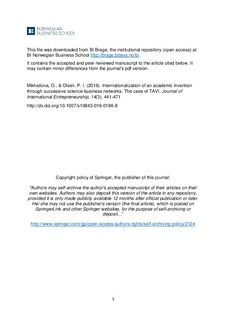Internationalization of an academic invention through successive science-business networks: The case of TAVI
Journal article, Peer reviewed
Permanent lenke
http://hdl.handle.net/11250/2435203Utgivelsesdato
2016Metadata
Vis full innførselSamlinger
- Scientific articles [2181]
Originalversjon
Journal of International Entrepreneurship, 14(2016)3, 441–471 http://dx.doi.org/10.1007/s10843-016-0186-8Sammendrag
The aim of this paper is to explain how new technology ventures move, grow, and scale. Such ventures internationalize much faster than depicted by the traditional Uppsala model (Johanson and Vahlne, J Int Bus Stud 8:23–32, 1977; Johanson and Vahlne, Mark Rev 7(4), 1990; Johanson and Vahlne, J Int Entrep 1:83–101, 2003; Johanson and Vahlne, Manag Int Rev 46:165–178, 2006; Oviatt and McDougall, J Int Bus Stud 25:45–64, 1994). According to the Uppsala model, the main reason it takes time is that entrepreneurs need to build networks and learn. Many scholars have investigated how they may be able to learn faster and grow networks more effectively. While these explanations contribute to a better understanding of the process, they appear disturbingly insufficient. By means of an in-depth case study, we aim at identifying how learning and network-building constraints may be circumvented. We have investigated the internationalization process of an invention at a Danish university hospital that became a new technology within minimally invasive heart surgery. While the invention took place in the periphery of the international medical network, the venture circulated to the most competent international science-business networks to mobilize resources and competencies. We found that its ability to succeed resulted from its roots in international academic networks and its connecting to core nodes in these as well as in adequate business networks—including, in particular, Venture Capital firms that are in the business of developing and scaling such technology ventures. We also found that the innovation process evolved through phases that called for different resources and capabilities. It thereby offered opportunities for actors, networks, and companies that control such capabilities to move in to take control and pull the venture through the next phase. The process is less like a long distance run, and more like a relay race. This radically reduces the need to learn as the new venture expands and scales.
Beskrivelse
The accepted and peer reviewed manuscript
